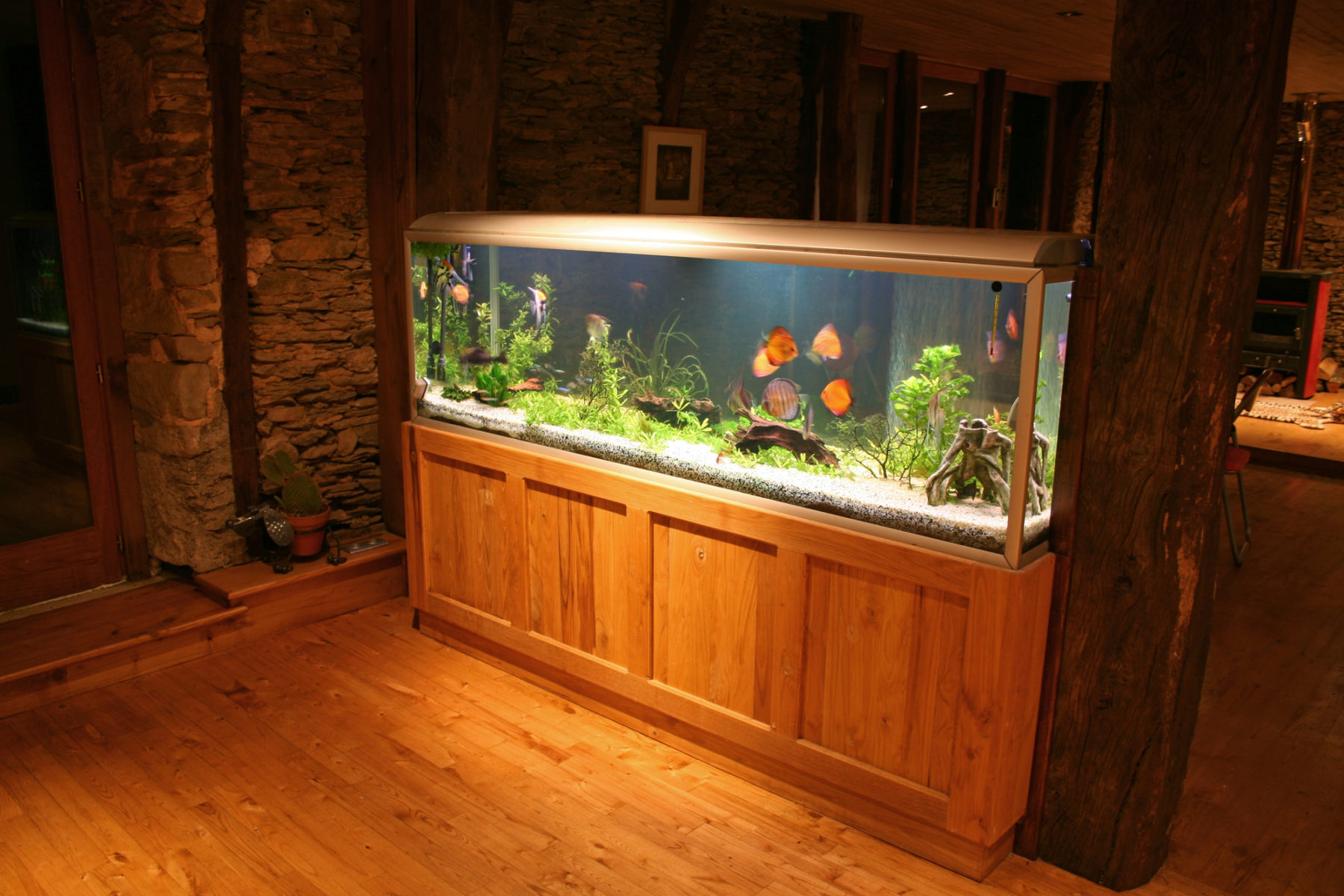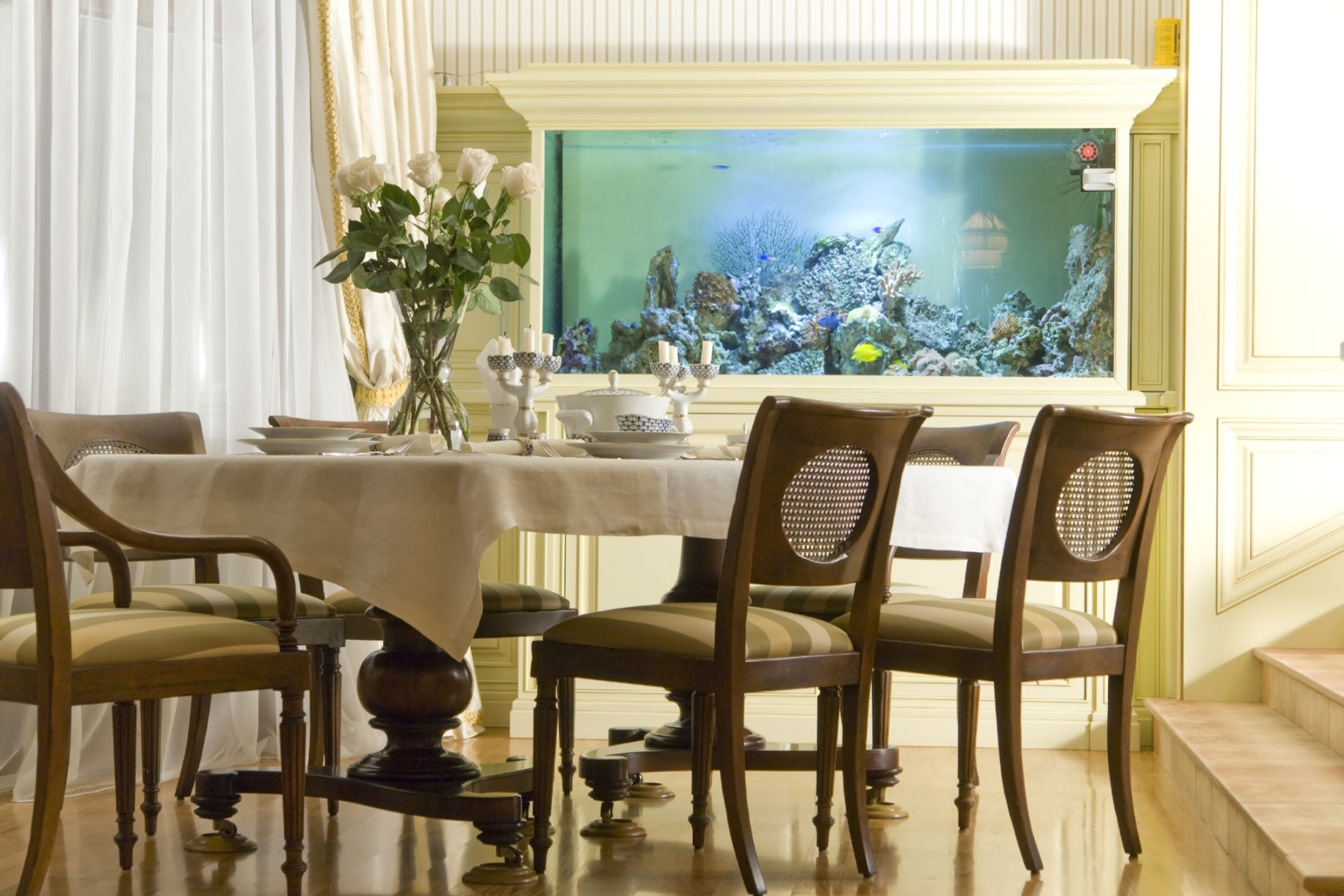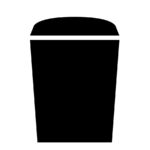Putting an Aquarium Together
As families come home from vacation, this time of year often finds people thinking about their homes and how to make them more enjoyable. I’m asked about installing home aquariums more often during the fall than at any other time. It is not necessarily complicated, but building a happy aquarium can involve thinking about a few things.
Where to Put the Aquarium
Before choosing an aquarium, it’s necessary to know where it will be located. An aquarium is as much a work of living art as it is a collection of pets, so making it an active part of your decor with prominent placement will help maximize your enjoyment.
The family enjoys the aquarium every day, and visitors almost always want to see it. So putting it somewhere where you entertain and where everyone sees it every day will help you get more out of your tank.
This is often in a living room or entertainment room. Sometimes it is placed next to the main focal point of the room, such as a tv, or it is treated as a second focal point, possibly on an adjoining wall.
If it will be placed on a stand, consider what the stand will look like. The aquarium stands on the market are functional, but they don’t always match or blend in well with the look of one’s home. A contractor or furniture builder can either modify the stand or build another to make the aquarium fit into the room more seamlessly. If it is going inside a wall, decide if it will be viewed on both sides from adjoining rooms, which will likely necessitate a custom tank. Most common aquarium sizes range from a two-foot cube on a pedestal to around 10-12 feet long. Most aquariums that I most often see in both homes and businesses are larger tanks four to six feet long.
When placing your aquarium, leave 6-12 inches of space on the sides and in back and at least 18 inches above the top for cleaning and access. Place it close to a source of electricity to avoid the use of unsightly extension cords. Many aquariums are placed above an electrical outlet from which one or two power strips are run, hidden by the stand. Provide space to mount the power strips off of the floor and to avoid getting them wet. Some people hire an electrician to run a line, if necessary.
Place larger aquariums by a load-bearing wall. A 75-gallon tank will easily weigh 1,000 pounds, which in my experience, has been fine in most locations. With larger tanks, the weight increases dramatically. Most floors can handle a load of this size, but it is always better to know beforehand. Hiring a contractor to check the floor to make sure it can hold the larger aquariums is advised for large aquariums.
The room in which the aquarium is placed should be kept at a consistent, moderate temperature. Aquarium water temperatures average approximately 75 to 80 degrees (I like 78 degrees). While most aquariums are equipped with some sort of heater, the ambient temperature determines how hard the heater has to work and how consistent the tank temperature is, which is very important to keep stable. Avoid putting the aquarium in direct sunlight; this will help prevent uncontrolled heating and help reduce or eliminate nuisance algae.
An important thing is to consider hiring an aquarium professional for a consultation. This will almost always get better results than relying on someone in a store who doesn’t know where the aquarium is going. A consultant can see the aquarium’s intended location and what is around it without having to guess. It’s also a good opportunity to get advice, but beware of “free consultations” that are often sales pitches in disguise. A consultation should answer your questions, make recommendations, and provide you with a list of everything you need, whether you choose to hire that professional or someone else for installation or maintenance.

Choosing the Aquarium
Many factors affect the type of aquarium you choose. Here is a list of the common aquarium types and the most important requirements for each:
• Most freshwater aquariums, including cichlid tanks, are not demanding at all. A simple filter, heater, and light are sufficient for most.
• Planted freshwater aquariums need high quality water and lighting that promotes photosynthesis.
• Saltwater Fish-Only with Live Rock (FOWLR) aquariums can be very forgiving, as long as good filtration is in place.
• A saltwater mixed reef needs excellent water quality and quality lighting that promotes photosynthesis
• Saltwater reef tanks need consistent pristine water conditions with brighter lighting in specific spectrums, depending on what is in the aquarium.
Choosing the Tank
When I am asked what size aquarium someone should get, I tell him or her that I believe that a person should get as large an aquarium as possible. For many, that means a capacity of 75-90 gallons. These tanks are normally four feet long and are on the smaller end of the large aquarium range. I don’t usually recommend a 55-gallon tank, because the difference between 55 and 75 gallons is small, as far as the footprint goes, but the difference is impressive in the way the aquarium looks and what can be put into it. Keep in mind that aquariums come in a wide range of prices. “More expensive” does not always equal “better,” although “cheap” often means “low quality.”
Acrylic aquariums are a little clearer than glass and are lighter, which makes a big difference in the larger sizes. However, they are easily scratched, so much so that there is a separate set of tools for cleaning acrylic tanks, and cleaning them generally requires more time and cautious effort. Glass aquariums are strong, but heavier than acrylic. Thicker glass can add a slight green tinge to the display, although it is mostly unnoticeable. It is simple to clean and harder to scratch.
Stick with the larger brands, such as Marineland, Aqueon, Deep Blue, and Red Sea. From what I have seen and what others tell me, these are all good quality and consistently reliable. I have experienced and heard of more problems with cheaply made aquariums.
Getting a “reef-ready” tank with built-in overflows can save a lot of headaches; it also hides pipes from view, making them a viable option for freshwater tanks, too.
Lighting
Lighting comes in four basic types: LED (Light Emitting Diode), metal halide, high output and very high output fluorescent and compact fluorescent.
LED lighting had a bad reputation just a few years ago when it was new. However, it has come a long way, and there is a large selection of lights available. Beware of cheap LED lights; this is one of those areas in which you get what you pay for.
I usually recommend one of a couple different lights to my customers, depending on how they will be used. Marineland makes a solid light that works well for many aquariums. The higher end lights come with blue dusk/dawn lights (actinic) and white lights, each with a timer built in. I have seen their reef lights grow several corals well. EcoTech Marine’s Radions are the light that other lights are compared to. They are very customizable, with sunset and sunrise, variable weather, lunar cycles, and can be controlled from anywhere with an internet connection using their ReefLink wireless device. Their outstanding customer service offsets what can be a difficult installation process.
T5 High-Output and Very High Output Fluorescent Lighting have been in use for quite a while, and are still widely used because they work well. T5 bulbs are narrow fluorescent bulbs with a very specific spectrum based on what they are meant to do. There are bulbs for plants, corals, and general purposes. They should be replaced every six to nine months, depending on the manufacturer and what one is trying to accomplish.
Metal halide lighting is the standard by which all other lighting is often measured. These lights are bright—the closest thing to putting the sun right on top of an aquarium. This performance comes with a cost, however: Metal halide lights are expensive to buy and to run, and generate considerable heat.
Compact fluorescents were the standard until other lights surpassed them. These dual-tube bulbs put out a strong light and can be set up with two spectrums. They aren’t out of the game yet, but someone getting into aquariums will be happier with a different choice.
Flow
Water in an aquarium should always be moving, just as in a fish’s natural home. This gets pollutants into the filtration system and out of the water. It also distributes oxygen and food throughout the tank, along with a variety of other tasks.
All aquariums have a main pump. It may be in a filter hanging on the back of the tank, or it could be in a separate tank, or “sump,” that handles filtration. If it is in the filter, it is almost always built in. If it is in the sump, it stands alone and returns water to the display tank.
Inside the tank, currents can be created with what is called a “power head.” Power heads are small fans that blow water through the tank. Saltwater aquariums need these, especially if they are reefs, or mixed-reefs. Freshwater tanks don’t necessarily need them, although they can be beneficial if set up correctly.
Life Support
The most important job an aquarium does is remove waste and waste materials from the water. The more efficiently a system does this, the better it is for the health of the aquarium system and its inhabitants and the happiness of the owner.
Hang-on-the-Back Filters
The entry level to filtration is the filter that hangs on the back of an aquarium tank. I have seen them perform well for both planted and non-planted freshwater and for saltwater fish-only aquariums.
While they are cheap and easy to maintain, they have drawbacks: I have seen several of these filters fail. They can become noisy and splash water on and around the aquarium. They have parts that often get stuck, and they are somewhat limited in what they can remove from the water.
There is a type of “pre-filter” which uses a U-tube to carry water over the back of the aquarium, draining into the sump below. These depend on a constantly clear siphon being maintained. If they get blocked or impeded, flow through the U-tube slows to the point where it doesn’t keep up with the water being pumped into the display, and a large amount of water ends up on the floor. In my experience, it has not been a question of “if” as much “when” this will happen.
Canister Filters
The next step up is the canister filter. These sit hidden from view below the tank, pulling water from the display and running it through a series of filters before returning it into the display.
The main disadvantage to canister filters is that they do not oxygenate the water as it is filtered. This can be overcome by making sure that it is done in the display either with a bubbler or creating enough surface movement to mix oxygen in the water.
However, canister filters are highly customizable. Different filtration media and methods can be used based on the needs of the aquarium, and are simple to reconfigure as those needs change.
Wet/Dry Filters
Wet/Dry filters are most often used on saltwater FOWLR tanks. They sit below the tank, and water from the display drains into a chamber filled with balls specially made to maximize surface area called “bio-balls.” Bacteria growing on the Bio-balls process dissolved wastes into less toxic compounds.
Wet/Dry filters were the industry standard for years. They oxygenate water quite efficiently, but after time, some of this collected waste material can get back into the tank. They also have a tendency to splash quite a bit, affecting the water’s salinity and making a mess in the stand.
Sumps
Sumps allow the maximum amount of waste to be removed from an aquarium. These tanks sit below the display tank in the stand, or even in some cases in another room. All water conditioning, filtration, heating, dosing chemicals, and other treatment happens in the sump, keeping unsightly equipment, tubes, and hoses out of the display.
Filtration Equipment
Aquarium filtration equipment includes filter socks, UV sterilizers, protein skimmers, bio-pellet reactors and more. While no filtration system is 100% effective, it is an essential part of maintaining a clean tank environment. Filter socks remove particles from the water and make it clearer. They are very efficient and can be reused, saving money over repeatedly buying filter material. UV Sterilizers run the water past an ultraviolet light that neutralizes parasites with UV radiation. The tanks that I have seen using these have a much lower instance of parasites, which is enough for me to generally recommend them.
Protein skimmers do not work in fresh water, but are a must for saltwater aquariums. A protein skimmer removes dissolved wastes from the water by creating thousands of micro bubbles with an electric charge which attract dissolved wastes to them. They stick together and are pushed up out of the water and into a collection cup that is removed, rinsed off, and reattached.
Bio-Pellet reactors work in conjunction with protein skimmers. They are filled with pellets that are a food source for certain heterotrophic bacteria that assimilate dissolved wastes into their bodies. Once they grow large enough, they fall out of the reactor and are removed by the protein skimmer.
Creating the living space
Decorations come in many forms, most available at any local pet store. Items obtained elsewhere should be thoroughly checked for safety and compatibility with both aquariums and fish. Metal items and components should be avoided.
For the interior, you may want to choose some sort of sand or gravel for the bottom, considering the color and size of the grains or pebbles. I often recommend a good crushed aragonite for saltwater tanks, and against black sand, since some black sands are magnetic, and black often shows fish waste prominently. You may also opt for nothing at all.
For freshwater aquariums, most customers are happiest with natural looking substrates, although some like brightly colored gravel. For planted tanks, I specifically recommend SeaChem’s Flourite Onyx Sand to my customers: Its gray color may not sound very exciting, but I have gotten many comments on how it makes the colors pop.
A large piece of driftwood or a small accent piece or two also add natural beauty to a freshwater tank, planted or otherwise. Prices for these decorations vary but can be expensive. Saltwater tanks generally use “live rock,” so called because of all the life that has developed on it in the form of bacteria, plant life, and other animals, such as sponges.
Rocks, wood and other decorations do more than simply look pretty; they also give the fish places to call home and to hide in. The more holes they can provide, the better. Keep this in mind while setting everything up inside the aquarium.
A happy aquarium means happy fish and happy pet owners. The list of “what to get” can seem long. But unlike with any other pet, an entire ecosystem is being created. Doing it thoroughly from the beginning creates a better experience for everyone.
David Green Co-Founder of ReefTechs Aquarium Consultants. He oversees aquarium maintenance operations and quality control. He is a SeaChem Certified Technician, an Atlanta native and a US Navy Veteran.
www.reeftechs.com









